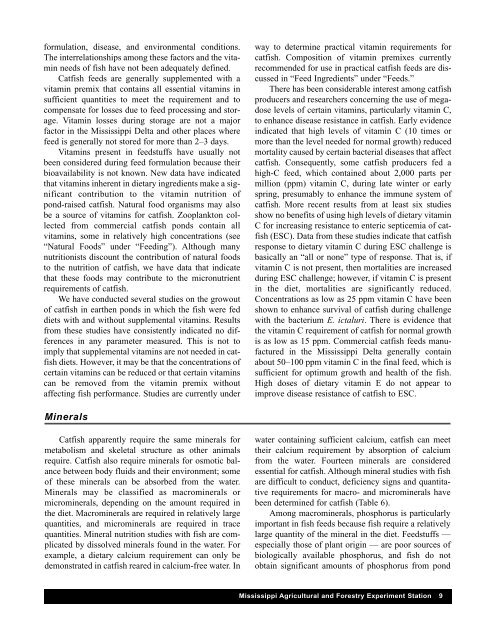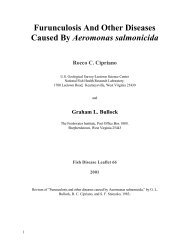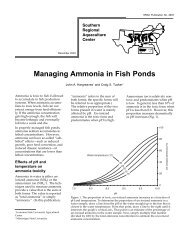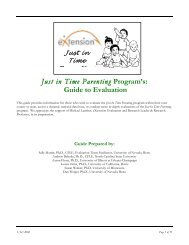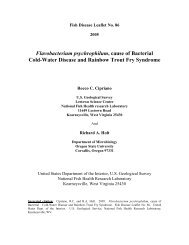A Practical Guide to Nutrition, Feeds, and ... - cop.eXtension.org
A Practical Guide to Nutrition, Feeds, and ... - cop.eXtension.org
A Practical Guide to Nutrition, Feeds, and ... - cop.eXtension.org
You also want an ePaper? Increase the reach of your titles
YUMPU automatically turns print PDFs into web optimized ePapers that Google loves.
formulation, disease, <strong>and</strong> environmental conditions.<br />
The interrelationships among these fac<strong>to</strong>rs <strong>and</strong> the vitamin<br />
needs of fish have not been adequately defined.<br />
Catfish feeds are generally supplemented with a<br />
vitamin premix that contains all essential vitamins in<br />
sufficient quantities <strong>to</strong> meet the requirement <strong>and</strong> <strong>to</strong><br />
compensate for losses due <strong>to</strong> feed processing <strong>and</strong> s<strong>to</strong>rage.<br />
Vitamin losses during s<strong>to</strong>rage are not a major<br />
fac<strong>to</strong>r in the Mississippi Delta <strong>and</strong> other places where<br />
feed is generally not s<strong>to</strong>red for more than 2–3 days.<br />
Vitamins present in feedstuffs have usually not<br />
been considered during feed formulation because their<br />
bioavailability is not known. New data have indicated<br />
that vitamins inherent in dietary ingredients make a significant<br />
contribution <strong>to</strong> the vitamin nutrition of<br />
pond-raised catfish. Natural food <strong>org</strong>anisms may also<br />
be a source of vitamins for catfish. Zooplank<strong>to</strong>n collected<br />
from commercial catfish ponds contain all<br />
vitamins, some in relatively high concentrations (see<br />
“Natural Foods” under “Feeding”). Although many<br />
nutritionists discount the contribution of natural foods<br />
<strong>to</strong> the nutrition of catfish, we have data that indicate<br />
that these foods may contribute <strong>to</strong> the micronutrient<br />
requirements of catfish.<br />
We have conducted several studies on the growout<br />
of catfish in earthen ponds in which the fish were fed<br />
diets with <strong>and</strong> without supplemental vitamins. Results<br />
from these studies have consistently indicated no differences<br />
in any parameter measured. This is not <strong>to</strong><br />
imply that supplemental vitamins are not needed in catfish<br />
diets. However, it may be that the concentrations of<br />
certain vitamins can be reduced or that certain vitamins<br />
can be removed from the vitamin premix without<br />
affecting fish performance. Studies are currently under<br />
Minerals<br />
Catfish apparently require the same minerals for<br />
metabolism <strong>and</strong> skeletal structure as other animals<br />
require. Catfish also require minerals for osmotic balance<br />
between body fluids <strong>and</strong> their environment; some<br />
of these minerals can be absorbed from the water.<br />
Minerals may be classified as macrominerals or<br />
microminerals, depending on the amount required in<br />
the diet. Macrominerals are required in relatively large<br />
quantities, <strong>and</strong> microminerals are required in trace<br />
quantities. Mineral nutrition studies with fish are complicated<br />
by dissolved minerals found in the water. For<br />
example, a dietary calcium requirement can only be<br />
demonstrated in catfish reared in calcium-free water. In<br />
way <strong>to</strong> determine practical vitamin requirements for<br />
catfish. Composition of vitamin premixes currently<br />
recommended for use in practical catfish feeds are discussed<br />
in “Feed Ingredients” under “<strong>Feeds</strong>.”<br />
There has been considerable interest among catfish<br />
producers <strong>and</strong> researchers concerning the use of megadose<br />
levels of certain vitamins, particularly vitamin C,<br />
<strong>to</strong> enhance disease resistance in catfish. Early evidence<br />
indicated that high levels of vitamin C (10 times or<br />
more than the level needed for normal growth) reduced<br />
mortality caused by certain bacterial diseases that affect<br />
catfish. Consequently, some catfish producers fed a<br />
high-C feed, which contained about 2,000 parts per<br />
million (ppm) vitamin C, during late winter or early<br />
spring, presumably <strong>to</strong> enhance the immune system of<br />
catfish. More recent results from at least six studies<br />
show no benefits of using high levels of dietary vitamin<br />
C for increasing resistance <strong>to</strong> enteric septicemia of catfish<br />
(ESC). Data from these studies indicate that catfish<br />
response <strong>to</strong> dietary vitamin C during ESC challenge is<br />
basically an “all or none” type of response. That is, if<br />
vitamin C is not present, then mortalities are increased<br />
during ESC challenge; however, if vitamin C is present<br />
in the diet, mortalities are significantly reduced.<br />
Concentrations as low as 25 ppm vitamin C have been<br />
shown <strong>to</strong> enhance survival of catfish during challenge<br />
with the bacterium E. ictaluri. There is evidence that<br />
the vitamin C requirement of catfish for normal growth<br />
is as low as 15 ppm. Commercial catfish feeds manufactured<br />
in the Mississippi Delta generally contain<br />
about 50–100 ppm vitamin C in the final feed, which is<br />
sufficient for optimum growth <strong>and</strong> health of the fish.<br />
High doses of dietary vitamin E do not appear <strong>to</strong><br />
improve disease resistance of catfish <strong>to</strong> ESC.<br />
water containing sufficient calcium, catfish can meet<br />
their calcium requirement by absorption of calcium<br />
from the water. Fourteen minerals are considered<br />
essential for catfish. Although mineral studies with fish<br />
are difficult <strong>to</strong> conduct, deficiency signs <strong>and</strong> quantitative<br />
requirements for macro- <strong>and</strong> microminerals have<br />
been determined for catfish (Table 6).<br />
Among macrominerals, phosphorus is particularly<br />
important in fish feeds because fish require a relatively<br />
large quantity of the mineral in the diet. <strong>Feeds</strong>tuffs —<br />
especially those of plant origin — are poor sources of<br />
biologically available phosphorus, <strong>and</strong> fish do not<br />
obtain significant amounts of phosphorus from pond<br />
Mississippi Agricultural <strong>and</strong> Forestry Experiment Station 9


